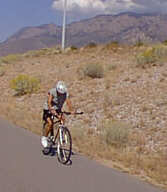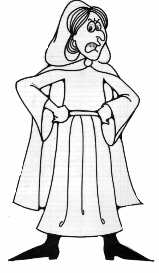The ideal human environment would be totally benign and safe. However, as a part of an environmental system, which is a mix of natural and man-made elements, there will always be risks to human beings. Although we cannot create an environment that is totally free of danger, we can try to reduce human exposure to harm and mitigate the effects of potential injuries (for example, by using seat belts). We can also improve our awareness and knowledge of the potential hazards around us.
Just as most families try to teach their children not to play with fire, electric wires, or harmful substances, so government agencies, schools, private businesses and citizen groups try to educate the public about other safety issues. Some of these issues include bicycle and pedestrian safety, driver safety, weather hazards, crime prevention, disease prevention and accident prevention.
In Albuquerque we have many agencies that educate the public about health-related hazards. The Poison Control Center has a 24-hour hot line and educational materials available to the public. The state health department provides information about disease control. The school system and other health agencies attempt to provide information to youth and others about preventing AIDS and other sexually transmitted diseases.
A person can call the National Weather Service for a message on local weather conditions or the New Mexico Highway Department for road conditions during bad weather. The National Forest Service distributes materials regarding hiking and camping safety practices.
An organization called the SAFE KIDS Coalition is promoting safety for children in a number of different areas: car seat usage, fire protection, poison control, water safety, traffic safety, and firearm safety. The goal of SAFE KIDS is to reduce the number of preventable injuries.
The Air Pollution Division of the city's Environmental Health Department (EHD) monitors the quality of the air in order to inform the public of current air quality and to reduce driving during periods of high air-pollution. The city and county prohibit wood burning on days when inversions occur. The EHD also provides information about pollution prevention and proper management of hazardous materials and hazardous waste.
 |
Automobile use--for drivers, passengers, and others, such as pedestrians and cyclists--is the area of greatest potential injury in our community. Automobile accidents account for approximately 75 deaths in Bernalillo County every year. Because of the convenience that cars offer, the number of cars owned per family has greatly increased. Streets are designed to move many vehicles at relatively high speeds, sometimes creating unsafe conditions for people who wish to walk or ride bicycles.
Several programs are in place or are being developed to address safety issues related to transportation. The Ridepool program promotes alternative modes of transportation and helps people share rides. Mothers Against Drunk Driving (MADD) and other groups have been making progress in reducing the incidence of alcohol-related accidents.
In 1995 the Albuquerque City Council, with support from the Mayor’s Office, found it important to begin addressing issues pertaining to bicycle and pedestrian safety within Albuquerque. This led to the creation of the City’s Bicycle/Pedestrian Safety Education Program. The mission of the program is to design and provide for the citizens of the Albuquerque metropolitan area educational activities and information which promote bicycle and pedestrian safety, bicycling and walking as alternative transportation modes, and the health benefits of cycling and walking.
A primary objective of the program is to increase the bicycle safety knowledge of Albuquerque Public School elementary Students (4th & 5th grade). From 1995 through 1998 over 15000 APS students have participated in bicycle safety presentations of bicycle safety "rodeos". In addition, bicycle safety presentations and "rodeos" are presented free of charge to civic, neighborhood, and community groups or organizations. Schools and individuals from the community are encouraged to contact the program for information on accessing this program.
The program receives federal funds for the promotion of bicycling as a means of transportation, "Sharing the Road" with bicyclists, and for improving our air quality by utilizing alternative transportation modes. Messages can be seen or heard throughout the year on television and radio. In addition, the program disseminates the Albuquerque Metropolitan Bicycle Map, assorted bicycle and pedestrian safety information, along with providing adults with "vehicular cycling" classes/training (courses designed to give bicyclists skills to safely and effectively use roadways for transportation). For information call 505-768-BIKE (2453).
The police department is working on promoting children's safety from crime. Children are taught at an early age the steps to take in various situations. McGruff the Crime Dog is the mascot of the Crime Prevention Council and he visits schools with police officers to train children on safety matters and crime prevention.
Crime, as it effects all ages and areas of the community, has become a major concern. The city is beginning a community-based policing approach, in which neighborhoods are encouraged to develop a direct line of communication to the police assigned to their area. Neighbors can form Neighborhood Watch organizations to keep an eye on each other's property and notify their neighbors or the police if they spot a problem. Police officers will come to their meetings to discuss problems and techniques to prevent crime.
 |
One problem that is unique to Albuquerque is arroyo and irrigation ditch safety. The water in the Middle Rio Grande Conservancy District irrigation ditches appears very inviting to children in the summer. However, because of the slippery, sloping sides, currents, and objects under the water, drownings occur nearly every summer. The arroyos carry storm water very swiftly from the mountains to the valley through the often straightened, concrete-lined arroyos in urban areas. Teenagers and children playing in the arroyo may be unaware of an upstream rainstorm. But water flow can become fast and deadly very quickly.
Local governments responsible for the arroyos and ditches have considered fencing them off as a safety measure, but this is not feasible, nor would it solve the problem, although some fencing in particular areas has been installed. Adding to the impossibility of fencing are right-of-way and maintenance roads that allow miles of access along arroyos and ditches.
The Albuquerque Metropolitan Arroyo Flood Control Authority (AMAFCA), the Middle Rio Grande Conservancy District, Bernalillo County and the City of Albuquerque have combined to mount a public safety education campaign to teach children to stay out of ditches and arroyos. Brochures, bumper stickers, and signs give the message: "Ditches are Deadly--Stay Away" and "Expect the Unexpected." The Ditch Witch and Water Monster characters visit schools and events. This program has been successful in raising children's awareness and reducing the number of drownings.
(Up to Section V, Back to Regionalism, On to Solid Waste Management)